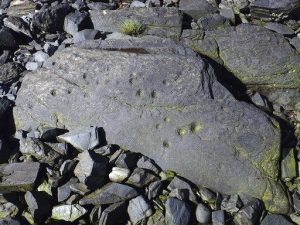Archaeologists discovered remains of a stone fish trap and a possibly associated with them petroglyphs on Northern Kodiak Island, Alaska, United States of America.

The stone trap is located in the lower intertidal zone, a muddy area below the mouth of a productive salmon stream. It is believed that at high tide, salmon headed up the stream could swim over the stone-walled feature, but as the tide dropped, fish were stranded in one of two corrals, stretching through 150 metres. The alignment of the remaining stones illustrates the shape and size of the original, ancient structure. Previously, researchers have found stone traps and wooden weirs from Southeast Alaska to the coast of Oregon. This recent find illustrates that people used this technology as far north as Kodiak. Experts state that although petroglyphs are a well-known feature of Kodiak’s cultural landscape, the fish trap is a rare find.

The previously undocumented petroglyphs were discovered on the shore, near the trap. The stone on which they were made, measures 1 metre across. The markings consist of a series of pecked, circular holes and faintly incised lines. Archaeologists assume that these carvings may be a territorial marker, but their meaning is unknown. It is believed that both the trap and the petroglyphs are part of a set of sites that include four Prehistoric villages dating back 2000 years.
(after Patrick Saltonstall, Alutiiq Museum, The Columbus Dispatch & Alaska Native News)